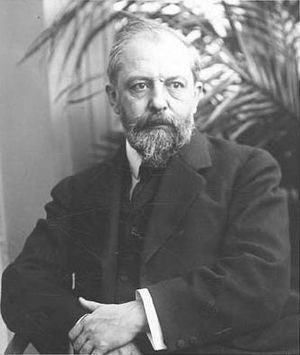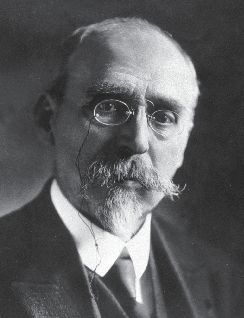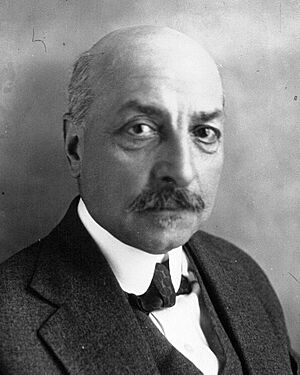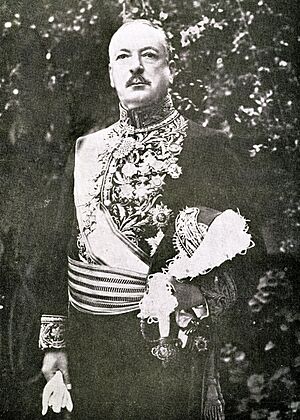Théodore Steeg facts for kids
Quick facts for kids
Théodore Steeg
|
|
|---|---|
 |
|
| Prime Minister of France | |
| In office 13 December 1930 – 27 January 1931 |
|
| President | Gaston Doumergue |
| Preceded by | André Tardieu |
| Succeeded by | Pierre Laval |
| Personal details | |
| Born | 19 December 1868 Libourne, Gironde, France |
| Died | 19 December 1950 (aged 82) Paris, France |
| Political party | Radical |
Théodore Steeg (born December 19, 1868 – died December 19, 1950) was a smart lawyer and philosophy teacher. He later became the Prime Minister of France, which is like being the head of the government.
Steeg started his political journey in France in 1904. He was part of the Radical Socialist party, but his ideas were usually quite balanced. He served as a Deputy (a type of elected representative) for Paris from 1904 to 1914. After that, he became a Senator (another type of representative) from 1914 to 1944.
During his career, he held many important jobs. He was a minister for education, interior (in charge of police and local government), justice, and colonies. In the 1920s, he led the French governments in Algeria and Morocco. He helped start big projects to bring water to farms. This was happening when local people wanted more rights, which sometimes caused problems. Steeg was Prime Minister for a short time in 1930–1931.
Contents
Théodore Steeg's Early Life
Jules Joseph Théodore Steeg was born in Libourne, France, on December 19, 1868. His family had German roots. Later, some of his political rivals used this fact to criticize him.
His father, Jules Steeg, was a Protestant pastor. He also worked as a journalist and became a politician himself. Théodore's mother was Anne-Marie Zoé Tuyès.
Théodore Steeg went to college in Libourne. Then, he studied at a famous school in Paris called Lycée Henri-IV. He went on to the University of Paris to study law. He was very good at his studies, coming in first place in 1887. He earned degrees in law and arts in 1890.
He then studied to become a philosophy teacher, again finishing first in 1895. In 1892, he married Ewaldine Bonet-Maury. They had three daughters together.

Théodore Steeg taught at a school in Paris from 1892 to 1894. After that, he became a philosophy professor in other towns like Vannes and Niort. In 1897, he helped start a group called the "People's Union." This group worked to improve education. He was the secretary of this group for two years.
He later returned to Paris and taught philosophy at two different schools until 1904.
Théodore Steeg's Political Career
Becoming a Deputy (1904–1914)
Théodore Steeg was elected as a Deputy for Paris in 1904. He was 35 years old at the time. He ran as a radical socialist and won the election.
As a new Deputy, Steeg quickly started working on protecting and educating children. In 1905, he also became a lawyer in Paris. He was re-elected easily in 1906 and 1910. He joined important committees, including one for the national budget.
In 1911, Théodore Steeg became the Minister of Public Instruction and Fine Arts. This job was about schools and art. A famous painting, the Mona Lisa, was stolen from the Louvre museum in August 1911. Steeg had to investigate how such a big theft could happen.
Steeg supported new ideas for the Sorbonne university. He believed in basic republican principles for education.
In 1912, Steeg became the Minister of Interior. This role involves managing internal affairs, like police and local governments. That year, doctors in Tunisia pointed out that there weren't enough places to treat people with mental illness in the colonies. Steeg worked to plan better mental healthcare in Algeria.
In 1913, Steeg briefly returned to his role as Minister of Public Instruction and Fine Arts. After that, he worked with another politician, Maurice Viollette. They tried to make laws better for children born outside of marriage.
Becoming a Senator (1914–1921)
Théodore Steeg was elected as a Senator for Paris in 1914. He joined a group called the Democratic Left. World War I started in July 1914.
During the war, in 1915, Steeg worked on finance and other special committees. In 1917, he became Minister of Public Instruction and Fine Arts again. He helped pass a law to support children whose parents died for the country. He then briefly served as Minister of the Interior again in late 1917.
After the war, Steeg was re-elected to the Senate in 1920. In January 1920, he was appointed Minister of Interior again. This was a bit surprising because his party was different from the one that won the election. Some people criticized his appointment, but the Prime Minister stood by him.
Steeg had to deal with a big strike in May 1920. Many workers, including transport workers and miners, stopped working. The government acted strongly to end the strike. Steeg said that trying to cause chaos in the country's economy was a crime. The strike ended without success for the workers.
Steeg stayed as Minister of Interior until January 1921. After that, he became the head of a new committee for general administration.
Leading Algeria (1921–1925)
In 1921, Steeg was made the governor-general of Algeria. This was a difficult time for the colony. Many Muslim Algerians had fought for France in the war and now wanted more political rights.
In 1922, the French President visited Algeria. He wanted to calm the fears of French settlers about the growing number of Muslim voters. Steeg allowed a local leader, Emir Khalid ibn Hashim, to speak to the President. Khaled asked for Algerians to have a voice in the French Parliament.
Steeg managed to calm things down and helped the economy grow. He believed in fair civilian rule in the colonies. He started big projects to bring water for farming, which helped improve agriculture. Because of this, he became known as the "water governor."
Steeg also supported cooperation between Algeria and other French colonies in Africa. They worked together to stop raids in the Sahara desert. In 1923, he met with leaders from Morocco and Tunisia to discuss common problems. They agreed to work together across borders.
In 1925, Steeg was called back to France to become the Minister of Justice. He was replaced in Algeria by Maurice Viollette.
Leading Morocco (1925–1928)

In 1925, a leader named Abd-el-Krim declared a new republic in Morocco. He fought against French forces. In October 1925, Steeg took over as the resident-general of Morocco. His job was to bring peace and change the government from military to civilian rule.
Abd-el-Krim surrendered in May 1926 and was sent to an island far away. Steeg wanted him to be "neither praised nor shamed, but in time forgotten."
Steeg quickly worked to solve social problems. He brought many more French people into the government. He also encouraged more French settlers to move to Morocco. In his first three years, he brought almost as many settlers as his predecessor had in thirteen years.
Steeg started huge irrigation projects, building dams to bring water to vast areas of land. This made new land available for French settlers and helped more people live there.
Steeg allowed Zionist (Jewish national movement) activities and newspapers. He said that educated Moroccan Jews should be able to become French citizens.
Some people worried that Steeg's policies were too focused on French settlement. They thought this might cause problems between the French and the local Moroccan people. Steeg wanted local leaders to join the French government. He thought this would make the government stronger.
Steeg spent less time with the Moroccan Sultan than the previous leader. He chose a young, new Sultan in 1927, perhaps hoping he would follow his wishes.
Steeg's policies led to traditional leaders losing power. Many local farmers moved to cities to find work. More French settlers came, and some were not very tolerant of the local people. This increased tensions.
There was a growing need for Moroccan workers. Socialists asked Steeg to create laws to protect workers, like those in France. Steeg said he could only study the idea because of the many foreign workers and the local people who were not yet ready for such measures.
Some groups with communist or pan-Islamic ideas started to appear. Steeg's security forces watched these groups. They often arrested leaders and took their materials.
In 1927, Steeg was re-elected to the Senate. He left his role in Morocco in January 1929.
Later Career (1929–1950)
From 1929 to 1935, Steeg was part of the Committee on Colonies. He became its president. He also worked on foreign affairs, Algerian issues, and education.
Steeg was briefly Minister of Justice in a government led by Camille Chautemps in early 1930.
In December 1930, Steeg became the President of the Council (Prime Minister). He was also the Minister of Colonies at the same time. His government was more left-leaning than previous ones. Some right-wing groups strongly attacked his new government. They even called his Minister of Defense "mad" and "corrupt." They called Steeg a "traitor" because of his German family background.
Even though he had support from the Senate, he couldn't get enough support in the main elected assembly. He lost a vote on farming policy and had to leave office in January 1931.
Steeg was elected to the Senate again in 1936. He continued to lead the committee on the Colonies. He also remained on committees for Foreign Affairs, Algeria, and Education.
In 1936, Steeg was asked to lead a group to study social and economic conditions in the French colonies. This group looked at working conditions in North Africa. However, they were too late to stop widespread worker unrest, which was put down with force.
Steeg was briefly Minister of Colonies again in 1938. He was against a plan to settle Jewish refugees in Madagascar. He believed that city-dwelling Jewish settlers would not be good farmers. He thought they would focus on small businesses, which he felt would harm the local economy. He also said the plan would be too expensive and criticized by the media.
World War II started in 1939. After France lost to Germany in 1940, Steeg chose not to vote on giving special powers to Marshal Philippe Pétain.
Théodore Steeg passed away on December 19, 1950, in Paris, on his 82nd birthday.
Summary of Cabinet Positions
| Ministry | Premier | Start | End |
|---|---|---|---|
| Public Instruction and Beaux-Arts | Ernest Monis | 2 March 1911 | 14 January 1912 |
| Interior | Raymond Poincaré | 14 January 1912 | 21 January 1913 |
| Public Instruction and Beaux-Arts | Aristide Briand | 21 January 1913 | 21 March 1913 |
| Public Instruction and Beaux-Arts | Alexandre Ribot | 20 March 1917 | 1 September 1917 |
| Interior | Paul Painlevé | 1 September 1917 | 16 November 1917 |
| Interior | Alexandre Millerand | 20 January 1920 | 24 September 1920 |
| Interior | Georges Leygues | 24 September 1920 | 16 January 1921 |
| Justice | Paul Painlevé | 17 April 1925 | 10 October 1925 |
| Justice | Camille Chautemps | 21 February 1930 | 1 March 1930 |
| Colonies | (self) | 13 December 1930 | 27 January 1931 |
| Colonies | Camille Chautemps | 18 January 1938 | 13 March 1938 |
| Minister of State | Léon Blum | 13 March 1938 | 10 April 1938 |
Steeg's Cabinet, 13 December 1930 – 27 January 1931
- Théodore Steeg – President of the Council and Minister of Colonies
- Aristide Briand – Minister of Foreign Affairs
- Louis Barthou – Minister of Defense
- Georges Leygues – Minister of the Interior
- Louis Germain-Martin – Minister of Finance
- Louis Loucheur – Minister of National Economy, Commerce, and Industry
- Maurice Palmade – Minister of Budget
- Édouard Grinda – Minister of Labour and Social Security Provisions
- Henri Chéron – Minister of Justice
- Albert Sarraut – Minister of Military Marine
- Charles Daniélou – Minister of Merchant Marine
- Paul Painlevé – Minister of Air
- Camille Chautemps – Minister of Public Instruction and Fine Arts
- Robert Thoumyre – Minister of Pensions
- Victor Boret – Minister of Agriculture
- Édouard Daladier – Minister of Public Works
- Henri Queuille – Minister of Public Health
- Georges Bonnet – Minister of Posts, Telegraphs, and Telephones
Changes
- 23 December 1930 – Maurice Dormann took over from Thoumyre as Minister of Pensions.
See also
 In Spanish: Théodore Steeg para niños
In Spanish: Théodore Steeg para niños



